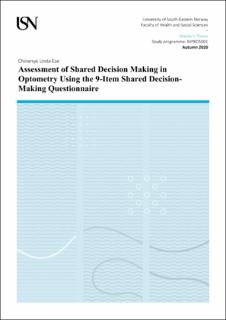| dc.description.abstract | Background: The perspective of both the patient and the optometrist have an enormous role to play during a clinical encounter. Nevertheless, few studies have been carried out to evaluate shared decision making in optometric practices. This study aims to evaluate shared decision making in optometry from the perspective of both the patient and the optometrist using the 9-item shared decision-making questionnaire (SDM-Q-9 and SDM-Q-Optometrist).
Material and methods: A cross-sectional, survey study was undertaken with participants recruited from Specsavers Norway. Optometrists working in Specsavers stores, and their patients were invited to take part in the study. In all, 12 optometrists from five stores and one to five of their patients volunteered to participate. Data was collected September to October 2020, and all the participants completed either the SDM-Q-9 or the SDM-Q-Optometrist. The Norwegian Centre for Research Data (NSD) approved the study. The statistical analysis was done in Excel/SPSS version 26 using frequency and summation statistics, group difference was analysed using Mann-Whitney U test. A p-value of <0.05 was considered statistically significant.
Result: The average (std) age of the optometrists was 42 (±11) years ranging from of 25 to 63 years. The years of practice for the optometrists was within the range of 1 to 38 years, with average(std) years of practice 17 (±12) years. The patients age was within the range of 18 to 80 years with an average (std) age of 52 (±20) years, where most of the patients were female (64%). The median sum SDM-Q-9 score and range for the patients was 41 and from 15 to 45, and for the optometrist, the median sum SDM-Q-Optometrist score and range was 40 and from 22 to 45. However, there is apparently greater variability in patients score compared to optometrists scores. There was no significant difference between the median SDM-9 item scores of the patients and the optometrists, except for item 5 relating to the understanding of all the information (Mann-Whitney U-test 41 versus 40, p=0.001).
Conclusion: In this study the patients’ perception of shared decision making were higher than the optometrists. The patients reported reasons for what the examination was about, and treatment decisions made matched what the optometrists reported. Patients and optometrists in general did perceived SDM to be satisfactory, however the aspects of provision of information needs more attention. One major limitation of this study is the use of a small sample population, further research using a larger sample size should expand our knowledge on shared decision making in optometric practices. | en_US |
